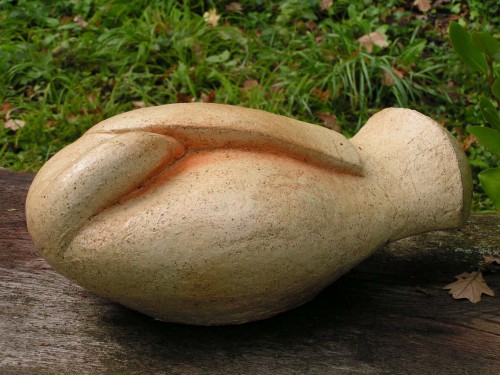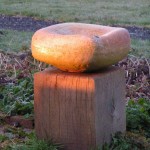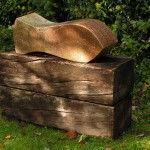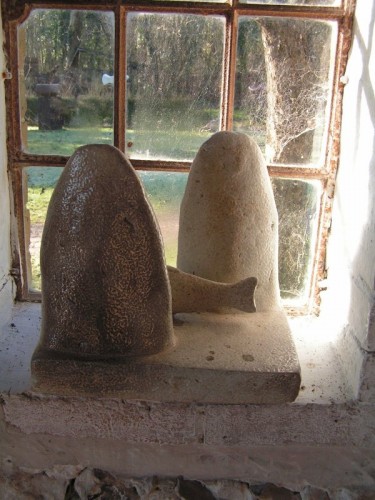
Here, she tells us about her work:
For years I’ve sold my Birdbaths as simply that. Only recently has it occurred to me to propose them to those looking for a Memorial. Why am I doing this? Because I believe they have the qualities that such a piece requires. I will try to explain.
I began making them in 1985 after having been a potter for the previous 10 years, one who made teapots,mugs, bowls and jugs. Their evolution was slow and co-insided with a time of reviewing early influences. Some people look at these birdbaths and ask if I acknowledge a debt to Henry Moore and Barbara Hepworth and I say ‘Yes, a huge one.’ But I also think it’s a case of those artists having also both looked at the same things as I have; at England’s landscapes, at the axe heads and megaliths of the Neolithic period, at Egyptian, Buddhist and Hindu stone carving, at the art of ancient Mesopotamia, at the surfaces of wood and stone eroded by water and wear, at the flints and pebbles beneath our feet. I saw in such forms and textures a language that I’ve tried to make my own.

When it came to evolving an upper surface that enabled water to have the necessary room to expand outwards and upwards on freezing it was the dew ponds in the South Downs I’d known since childhood that offered a solution. While a ceramic student I was struck by photos of Tibetan Stupas on Himalayan mountainsides. These tied in with the cairns I’d seen along tracks in the Lake district and Norwegian mountains, the same landscapes where I’d seen tarns encircled by hills. In my Birdbaths I’ve tried to recreate on a small scale what I saw on a larger one there.
Later in the work of the Romanian sculptor Brancusi I saw how this artist incorporated the pedestal base so that it became an integral part of his sculptures. I have conceived the bases of these Birdbaths in a similar way; their bases are an essential part of the piece as a whole. There are other people who say there is something ecclesiastic about the Birdbaths and again I say ‘ Yes, certainly.’ Because I’ve criss-crossed England looking at Saxon and Norman churches with their intimate chancels, their deeply recessed windows, their worn stone flags, their polished oak surfaces, their fonts, doorways and towers.
Recently someone said he saw something sad in the birdbaths. I beg to differ. I don’t deny their austerity but I employed this consciously at the very outset believing it could be a safe vehicle for strongly sensual qualities. There’s a gravity in the work of such painters as Giotto, Masaccio, Piero della Francesca, Rembrandt and Velasquez that exists alongside a profound tenderness. From studying them I got a taste for seeing these two things combined.. I’ve seen this combination in all kinds of great art since.

As well as birdbaths I make birds that are hollow and can serve as Cremation urns. For a long time this bird has determinably had its head tucked under a wing in sleep, something I saw beside a local pond some 12 years ago. For almost as long a customer has urged me to try a form with more inherent movement , perhapes a bird about to launch itself in flight. But I see now that what interests me is to find an image that at one and the same moment has both vitality and stillness.
Some practical points.
- The Birdbaths are not at all porous being made in high-fired Salt glazed stoneware. They are therefore frost proof. [Those of you reading this in the North of England will be familiar with the robust sinks, pipes and garden ware produced around you for centuries in this technique.] They will withstand English winters – with a caveat. Because water when it becomes ice has the power to crack open the hardest granite, so too ice if it stands in these birdbaths for months in sub-zero temperatures, can in a small percentage of cases crack these birdbaths. To avoid any risk of this do the following. Empty the birdbath of its water once heavy frosts arrive. Cover the birdbath so that no more rain can collect in it. When the hardest weather is past uncover it. Then the piece will last millennia.
- Five shapes are produced .But by virtue of their making and firing processes no two pieces are alike or able to be repeated exactly.
- Some people choose to have a metal plaque recessed into the wood base on which a dedication may be engraved. Such a plaque can be provided by Sarah Walton.
- Sarah Walton’s work may be seen on her website www.sarahwalton.co.uk and she may be emailed on smwalton@btconnect.com She is happy to send digital images of current stock and if a piece has been selected in this way to arrange its dispatch via a courier.
- She is also happy to have visitors to the studio at Keeper’s, Bopeep Lane, Alciston, Near. Polegate, East Sussex, BN26 6UH. where there is an extensive display of her Birdbaths and Birds. This is how the majority of customers have always bought these pieces. She has become adept at getting Birdbaths and their bases into customers car boots!
- She recommends that the Birdbath be sited in a secluded part of a garden, but somewhere where a viewer may enjoy the sight of its use from a comfortable armchair indoors – or from the kitchen sink.
- The oak bases are very heavy. Strong people are required to locate them. An 18” square concrete slab is best positioned beneath the wood base to avoid it becoming sodden by standing directly on earth or turf. These may be supplied with the Birdbath.
- Re-siting a Birdbath after its initial positioning is not unusual. It can take time to discover the very best place for one.
- PRICES.
Nos.1,2,3 and 5 shapes [ including their oak base ] are 997 pounds each plus 100 pounds for P & P.
No.4 shape [ including an oak base ] is 1225 pounds plus 100 pounds for P & P.
Provision of a plaque in brass, copper or bronze on which is engraved a dedication is a further 75 pounds.

Fish passing between stones (not for sale)

